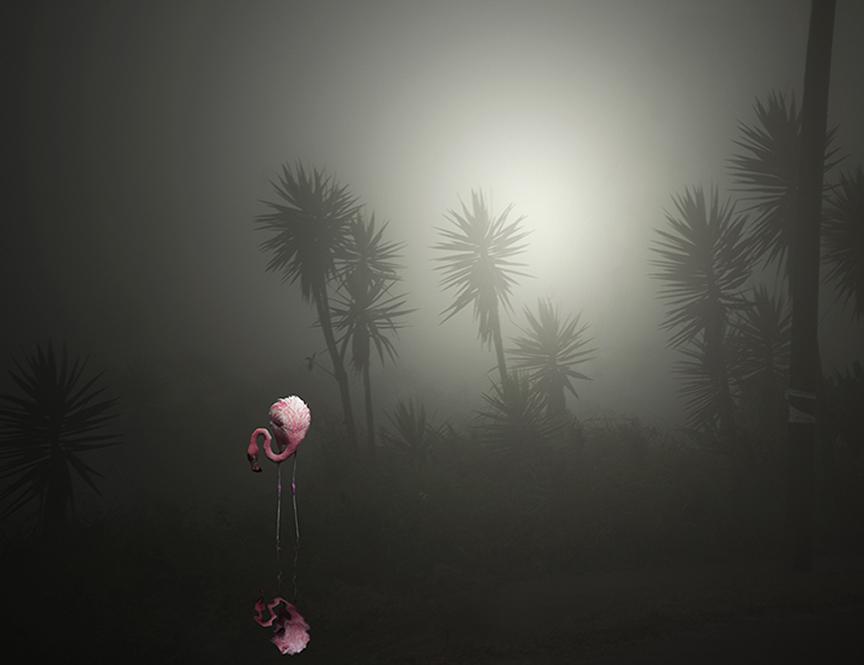Lost Flamingos in the Cloud Forest - Pat Swain, THE FENCE

This blog is part of a series of exclusive interviews with the winners of United Photo Industries’ (UPI) pioneering Brooklyn-based public photography installation THE FENCE.
---
Pat Swain is an award-winning photographer whose work has been shown extensively around the world. Among the many publications her photographs and digital art have appeared in are Leonardo (MIT Press), the New York Times, Digital Fine Art, Spin Magazine, New York Magazine. She holds a B.A. from Mount Holyoke College, an M.F.A. from Pratt Institute, and an M.A. from Columbia University.
Her series ‘Lost Flamingos in the Cloud Forest’ was selected as part of THE FENCE 2015.
Hi Pat. Please tell us a bit about yourself and how you got into photography
I took an art course in high school and discovered that I couldn’t draw. After a few weeks, I transferred to photography. It was a magical moment when my very first picture appeared in the developer. Then and there, I fell in love with photography.

Where did you find the inspiration for ‘Lost Flamingos in the Cloud Forest’, selected as part of THE FENCE 2015?
In the summer of 2012, I attended an artist residency, Odysseys Artist Residency, located in the Cloud Forest of Costa Rica. I was very taken by the beauty of this ‘cloudy’ forest. It was moody, often monochromatic because of the density of the clouds. It had a captivating, romantic feel. The Cloud Forest is at high elevation and the terrain is varied with jungles, fields, villages, etc. When I returned to NY, I was wondering what I could do with these landscapes that I photographed. Shortly after, I was wandering through the Bronx Zoo and came upon flamingos. The flamingos’ sculptural forms and vibrant pinks seemed to be a striking contrast against the subdued background of the Cloud Forest.
But I really don’t know how I come up with these ideas; they have a life of their own. However, I do have a gift for associating and combining seemingly disassociated ideas. This creates interesting situations.
Can you tell us a bit about the photographic process making the series?
After photographing various environments, birds, animals, and skies, I pick and choose, then composite and compose the elements together using Photoshop. Form, shape, colour, dark, and light are also major considerations.

How much work goes into each of the images both on-site and post-production?
On-site I shoot either with a monopod or handhold my camera. Beside the scene itself, I take close-ups of the different components to insure sharpness. I might have to use these parts for compositing in the post-production creation of an image.
The images involve labour intensive post-production in Photoshop. One image can take many, many hours that can turn into many days, which can turn into weeks. This is partly because I am creating an image, not just editing a photo. Some images, of course, are faster than others to create.
How did ‘Lost Flamingos in the Cloud Forest’ compare to other projects you have worked on?
‘Lost Flamingos in the Cloud Forest’ has been my most successful series. Overall, this series has a sense of beauty, I believe, which is more appealing compared to a quirkiness that predominates other projects. And everyone seems to love flamingos. I have sold these images to designers and collectors.

You began your professional photography career back in 1983. How did you find the transition from analogue to digital photography?
As the digital world began to emerge, I entered Pratt Institute for an M.F.A. in 1992. At that time, photography departments did not have computers. As I wanted to learn the technical / computer skills and future trends in photography, I enrolled in the program of Computer Graphics / Interactive Media (with an emphasis in photography). Various photography professors and I researched the computer in relation to photography, in a sense we were pioneers. Since then, I have been involved with digital imaging as a teacher and artist.
What is the secret to keep motivated when working on long-term projects?
For me, I must love the project to keep pushing it onward. I also test out new images by entering photo competitions. In addition, I post on Facebook certain images to see the likes and comments. All this fuels the life span of the project.
What is your next project?
I have started a new series entitled ‘Unlikely Water Animals’. Again it is an exploration of beauty out-of-place. This time the backdrop is beaches in which I compose animals ranging from farm to wild and exotic.
Anything else you would like to add?
I was very honoured to be on THE FENCE and I have sold some of those images because of that! Thank you very, very much. It has been great fun and wonderful exposure.
patswainphotography.com
fence.photoville.com







